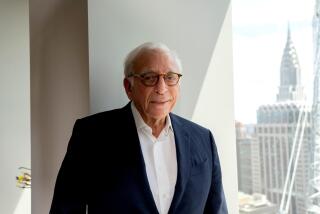Shamrock Hopes for Luck in Developing a Polaroid Takeover
Shamrock Holdings President Stanley P. Gold is eager to show people how much he wants to run Polaroid Corp., the instant-photography giant Shamrock is offering to buy for $2.4 billion.
Gold even promised the Boston Globe that if the Burbank investment firm succeeds in buying Polaroid, he’ll swap Shamrock’s prized season tickets to Los Angeles Lakers basketball games for those of the team’s archrivals, the Boston Celtics. The Celtics play in Boston Garden, just a few miles from Polaroid’s headquarters in Cambridge, Mass.
Shamrock employees have since pleaded with him not to part with the Lakers tickets. So he’s revised his promise. If he bags Polaroid, he’ll keep the Lakers tickets and buy new Celtics tickets.
Neither goal will be easy to achieve: Polaroid wants nothing to do with Gold; as for the Celtics, there is an 18-year wait for season tickets.
Undaunted, Gold vows to make Polaroid the latest catch for Shamrock, an investment vehicle for the family of Roy E. Disney, nephew of the late Walt Disney. Shamrock already owns about 7% of Polaroid’s stock.
Hearing Set
Polaroid’s future is likely to be determined by a Delaware Chancery Court lawsuit filed by Shamrock that will be heard this week. In hearings scheduled to start Wednesday, Shamrock will seek to overturn the chief obstacle Polaroid has thrown in its path--an employee stock plan that effectively puts enough Polaroid shares in friendly hands to make it virtually impossible for Shamrock to complete a merger.
The Polaroid employee stock plan enacted last July places 14% of Polaroid’s shares in the hands of employees. Nearly all the shares were bought with $285 million in loans that employees will pay back with their earnings through what amounts to a 5% deduction from their pay. Gold and Shamrock contend the plan is an anti-takeover scheme devised by Polaroid executives to protect their jobs.
Polaroid declined a request to interview any of its senior executives. The company’s chief spokesman, Samuel A. Yanes, said that the company has been considering an employee stock plan for years. He said a plan was authorized by directors in March, well before Shamrock surfaced as a suitor in July.
If the employee stock plan is struck down, Polaroid may be forced to find a friendly buyer, make a drastic defensive move such as selling a minority stake to a friendly party or risk being taken over in an unfriendly deal by Shamrock.
If the plan is upheld, Shamrock’s bid may be moot, because laws in Delaware, where Polaroid is incorporated, require a suitor to have at least 85% of the stock before forcing a merger. If Shamrock loses its suit, Gold acknowledges that a takeover will be more difficult but says that a loss in court “won’t be a showstopper.”
To make its bid, Shamrock has assembled an array of partnerships, but also has been secretive about disclosing the names of its limited partners. One, according to Securities and Exchange Commission filings, is Elders IXL, an acquisition-minded Australian company that is one of that country’s largest firms and which on Monday bid $2.9 billion for Great Britain’s Scottish & Newcastle brewer.
Elders, probably best known for its Foster’s Lager in the United States, is required to commit nearly $50 million to the Polaroid bid. Elders could be a powerful Shamrock ally should the bidding escalate.
“The plans they have for Polaroid make a lot of sense. We think there is some real value they will bring to a transaction,” said Warren Idsal, an executive vice president with the company’s Elders Finance Holdings USA.
Second Partner
Another Shamrock partner is Yvette Bluhdorn, widow of the late Charles G. Bluhdorn, who was chairman of Gulf & Western Industries until his death in 1983. Gold, a former managing partner in a Hollywood entertainment law firm, has served in the past as Yvette Bluhdorn’s lawyer.
Bluhdorn, whose contribution to the partnership is listed in filings as $8 million, declined to be interviewed. Gold is personally a partner in the bid as well, with a contribution listed at $3 million.
The 3-month-old takeover fight between Polaroid and Shamrock has effectively been in limbo until this week’s court hearing, with the battle taking place largely through press releases, letters, newspaper advertisements and lawsuits. Last week, Shamrock won a victory when Polaroid was denied a court order to stop its offer, although the lawsuit being heard this week is considered more critical in determining Shamrock’s chances.
Lobbying Workers
Last week, Gold took the unusual step of lobbying Polaroid’s employees through full-page ads in the Boston Globe and Boston Herald newspapers. Among other things, he accused Polaroid Chief Executive I. MacAllister Booth of “attempting to create fear and concern among Polaroid’s work force.” He also vowed to restore pay cuts and said he wants to meet with Polaroid employees, a request Polaroid turned down.
After reading Gold’s ad, Nick Pasquarosa, chairman of the Polaroid Employees Committee, which represents 10,000 Polaroid workers, said: “He thinks we are somewhat naive. About 85% to 90% of our employees now oppose Stanley Gold.”
The battle for Polaroid began earlier this year when the New York investment banking house Wertheim Schroder brought Polaroid to Gold’s attention as an “undervalued situation.” Gold said although he’d owned two Polaroid cameras, he knew little of the company. But he was sold on the company as an investment within a day.
Spotty Earnings
Founded by Edwin Land 51 years ago, Polaroid’s reputation as a technological leader has been tarnished in recent years. Earnings have been inconsistent, although last year it posted record sales of $1.8 billion as well as a record $1.88 earnings per share. The company’s fortunes also have received a boost from a patent-infringement case it won against Eastman Kodak, which forced Kodak to quit the instant-camera business. A trial to determine damages is scheduled for January, with securities analysts speculating that Polaroid’s award is likely to be between $1 billion and $2 billion.
Polaroid’s problem largely is that it has lost ground in the photography market, slipping from one-third of the amateur market in the 1970s to about 15% now. Polaroid has been hurt in part by the growth of one-hour photo labs and the development of easier-to-use 35-millimeter cameras.
Still, its name is one of the most recognized among consumers and the Polaroid name, Gold believes, is one of the company’s most valuable assets. “It’s a terrific household name with clear identification,” he said.
Foreign Markets
Gold believes that Polaroid needs a new marketing plan, including selling its cameras to nations such as the Soviet Union, China and India that are eager to improve their standards of living. He also wants to make Polaroid cameras more “event-oriented” by emphasizing the sale of camera packages to new parents or children, and he wants to push Polaroid’s technical and industrial business, which accounts for 40% of its business with such products as electronic imaging equipment and security systems.
Meanwhile, to fend off Gold and Shamrock, Polaroid announced a restructuring that would include trimming its work force by as many as 1,500 people through a voluntary severance and retirement program, the creation of the stock plan and plans to sell Polaroid-brand 35-millimeter film. Polaroid says it will save $100 million a year. In addition, the New York investment firm Forstmann Little & Co. is said to be interested in arranging a friendly buyout of Polaroid.
Gold isn’t impressed by Polaroid’s plans, especially its decision to enter the 35-millimeter film field now dominated by Kodak and Japan’s Fuji.
“You submit that as a comprehensive business plan at a decent MBA school and you’d fail the class,” Gold said.
Polaroid Confident
Polaroid’s Yanes said the company believes its name recognition is so strong that selling the 35-millimeter film will work, adding that Polaroid has successfully test marketed the film in Spain and Portugal. He added that Polaroid entered the blank videotape business late, but has been successful nonetheless.
According to Forbes, Roy Disney is worth $500 million. But Gold has said that he works with the goal of enriching future generations of the Roy Disney family.
Shamrock’s success record at taking over its targets is mixed. In 1985, it bought Indiana soybean processor Central Soya, earning a $125-million profit for itself last year when it sold the company to an Italian firm. Earlier this year, the investment firm Adler & Shaykin outbid Shamrock for Wherehouse Entertainment, a chain of video and music stores in Torrance. Later, Wherehouse bought the smaller, privately held Music Plus chain for an undisclosed amount.
Gold says that Central Soya’s directors opposed Shamrock’s bid initially, but ultimately negotiated an agreement. So too, he predicts, will Polaroid.
“This one’s going to get friendly in the end,” he said.
POLAROID’S 1988 STOCK PRICE Price per share July 20: $40...Shamrock offers $40-a-share plus part of Kodak award.
Sept. 9: $41.75...Shamrock launches $42-a-share tender offer.
More to Read
Inside the business of entertainment
The Wide Shot brings you news, analysis and insights on everything from streaming wars to production — and what it all means for the future.
You may occasionally receive promotional content from the Los Angeles Times.










